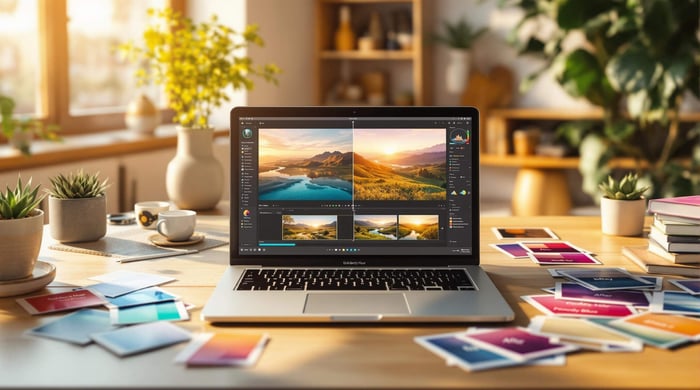Photography Statistics 2024: Trends Every Photographer Needs to Know
- Top Trends: Cinematic photography, black-and-white revival, bold color styles, and intergenerational themes are shaping the creative landscape.
- Tech Advances: AI tools for editing, accessible drone photography, and eco-friendly practices are transforming workflows.
- Market Insights: The global photography market is valued at $105.2 billion and is set to grow to $161.8 billion by 2030.
- Emerging Genres: Wedding, portrait, corporate, and pet photography are shifting toward authenticity and natural settings.
- Editing Trends: Lightroom presets and AI-powered tools are streamlining post-processing while keeping artistic styles intact.
Quick Overview Table
| Trend/Insight | Details |
|---|---|
| Popular Styles | Cinematic, black-and-white, bold colors, intergenerational photography |
| Tech Innovations | AI tools, drones, eco-conscious practices |
| Market Growth | $105.2B in 2023 → $161.8B by 2030 |
| Key Genres | Wedding, portrait, corporate, and pet photography |
| Editing Tools | AI editing, Lightroom presets, mobile-friendly tools |
Photography statistics in 2024 is all about balancing creativity with technology while adapting to new client demands. Dive into the article to explore how these trends can impact your work and business.
Photography Statistics: Trends to Watch in 2024
Popular Visual Styles in 2024
Photography statistics about styles are evolving with a focus on storytelling, aesthetics, and emotional depth. Cinematic photography is taking center stage in 2024, offering richer narratives and dramatic compositions that draw inspiration from the world of film [1][4].
Black-and-white photography is regaining popularity, admired for its timeless quality and ability to highlight contrasts and textures. Meanwhile, bold and vibrant color photography is thriving in digital spaces, capturing attention with its striking palettes and high-impact visuals [1][4]. Another growing trend is intergenerational photography, which beautifully portrays connections between different age groups, reflecting the shifting dynamics of modern families [1][4].
| Visual Style | Key Characteristics |
|---|---|
| Cinematic Photography | Story-focused, dramatic lighting, film-inspired |
| Black-and-White Revival | Timeless look, strong contrasts, classic appeal |
| Bold Color Photography | Bright tones, high contrast, eye-catching hues |
Based on recent photography statistics, these trends highlight the creative possibilities in photography while technological advancements are transforming how photographers approach their craft.
Advances in Photography Technology
AI tools are becoming more advanced, offering features like seamless background removal and noise reduction, which streamline editing workflows [1][3]. The photography industry, valued at $105.2 billion, is being reshaped by these innovations, enabling photographers to work more efficiently and creatively [3].
Drone photography is now more accessible, allowing photographers to experiment with aerial perspectives that were once out of reach [1][2][4]. Additionally, there is a growing shift toward eco-conscious practices, such as digital deliveries and sustainable product offerings, aligning with clients' increasing demand for environmentally friendly solutions [2][4].
Key shifts in technology include:
- AI-powered tools: Simplify editing and enhance workflow efficiency.
- Drone accessibility: Opens up new creative perspectives.
- Advanced processing: Delivers higher-quality images.
- Eco-conscious practices: Support sustainability without compromising creativity.
These technological changes are not just improving efficiency but also expanding the creative horizons for photographers in 2024.
Insights for Photographers in 2024
Photography Genres on the Rise
In 2024, the world is expected to capture a staggering 1.94 trillion photos - about 5.3 billion every single day [5]. This massive number highlights the endless possibilities across various photography niches. While wedding and portrait photography remain staples, the way these genres are approached is shifting.
"In 2024, authenticity is key, with clients seeking genuine, personality-driven moments" [2].
| Photography Genre | Emerging Trends |
|---|---|
| Wedding Photography | Candid shots with storytelling focus |
| Portrait Photography | Natural settings, often outdoors |
| Corporate Photography | Emphasis on virtual teams and remote work |
| Pet Photography | Lifestyle photography, often outdoors |
Intergenerational photography is also gaining traction. This niche celebrates family connections and offers a great opportunity for portrait and event photographers [1][4]. As these genres evolve, staying flexible and refining techniques will help photographers stand out in an increasingly crowded market.
Staying Ahead in the Industry
Thriving in 2024 means combining creativity with strong business skills, while embracing new tools and practices. Keeping up with trends and technology is no longer optional - it's essential.
Key areas to focus on:
- Mastering Technology: AI tools and drone photography are changing the game, offering fresh perspectives and more efficient workflows [2][4].
- Eco-Conscious Practices: Digital deliveries and sustainable packaging are becoming industry norms [2].
- Inclusive Representation: Prioritizing diversity in photography to reflect a range of cultures, ages, and experiences [1][4].
Social media trends are also reshaping the way photographers work. Vertical compositions, designed for mobile screens, are now a must for creating engaging content [5].
"The revival of Zine Culture and symbolic photography encourages deep thought and creative expression, offering photographers new ways to showcase their work" [1].
Zine Culture, a DIY publishing movement, and symbolic photography, which relies on metaphorical imagery, are making a comeback. These trends allow photographers to explore new creative outlets and connect with niche audiences [1]. Staying in tune with these shifts will help photographers remain relevant in an ever-evolving industry.
Editing and Post-Processing Trends for 2024
Why Lightroom Presets Are More Popular Than Ever
With the photography industry expected to hit $161.8 billion by 2030 [3], photographers are looking for faster, more efficient ways to edit. Lightroom presets have become a go-to solution, offering a way to save time, maintain a consistent style, and deliver professional-quality results.
| Preset Benefits | Impact on Workflow |
|---|---|
| Consistent Style | Keeps a uniform look across photo collections |
| Time Efficiency | Cuts down on manual adjustments |
| Quality Control | Helps ensure polished, professional results |
| Batch Processing | Simplifies editing multiple photos at once |
"Minimalistic editing is rising, preserving the natural beauty of moments" - Jillian Goulding, Photographer [2]
Presets have evolved into more than just shortcuts; they’re starting points that allow photographers to streamline their process without losing their artistic touch. The focus on natural tones and true-to-life colors has sparked demand for presets that enhance photos while keeping them realistic.
While presets boost efficiency, AI-powered tools are taking things a step further, giving photographers smarter ways to edit and optimize their workflow.
New Tools for Faster Editing
AI technology is reshaping the way photographers handle post-processing, making it easier for both seasoned professionals and beginners to achieve high-quality results. Mobile editing tools now make quick edits and instant client delivery more accessible than ever.
Some of the latest advances in editing technology include:
- Mobile presets for quick edits anywhere
- AI-powered batch processing for faster workflows
- Automated color grading for polished tones
- Intelligent noise reduction for cleaner images
- Tools for automatic background removal
Platforms like Capture One and Luminar NEO are also stepping up with specialized features tailored for portrait and landscape photography. The growing interest in experimental and pattern-focused styles [1][4] has inspired the creation of more creative preset options to match these trends.
While automation simplifies the technical side of editing, the most successful photographers balance these tools with their personal artistic style. This combination ensures their work stays both competitive and true to their creative vision in 2024.
Conclusion: Preparing for Changes in Photography
Key Trends Shaping Photography in 2024
The photography statistics world is shifting, driven by advancements in AI, drone technology, and changing audience expectations. These developments are influencing how photographers approach their craft, from workflows to creative concepts. Staying ahead means understanding these changes and using them to explore new opportunities.
| Trend | How It Affects Photography |
|---|---|
| Vertical Composition | Crucial for mobile-first platforms |
| Symbolic Photography | Opens doors for deeper storytelling |
| Intergenerational Focus | Broadens audience appeal and portfolio diversity |
| Client Experience | Prioritizes digital delivery and eco-friendly practices |
With mobile-first content dominating, vertical compositions are no longer optional - they're a necessity. Photographers need to refine their techniques to fit this format while keeping their artistic essence intact [1].
Balancing Technology and Creativity
Success in 2024 will depend on blending cutting-edge tools with a strong creative vision. Trends like symbolic and intergenerational photography offer fresh ways to connect with audiences and expand artistic horizons [1][4].
"The integration of AI in photography isn't just about automation - it's about enhancing creativity while maintaining the human touch that makes each photographer unique." - Industry expert insight [1]
Focusing on eco-conscious practices and inclusivity will not only align with industry growth but also resonate with modern clients [2]. With the global photography market expected to hit $161.8 billion by 2030 [3], those who embrace both innovation and evolving artistic approaches will be well-positioned for success in this ever-changing field.
AI Photo Editor for Wedding and Portrait Photographers
FAQs
Here are answers to some important questions about the evolving photography industry.
What is the future of the photography business?
According to photography statistics, the global photography market is valued at $105.2 billion in 2023 and is expected to grow by 4.4% annually, reaching $161.8 billion by 2030 [3]. North America continues to lead the market, offering strong opportunities for photographers [3].
To thrive, photographers need to blend AI tools with their creative vision. Expanding services and adopting emerging technologies while maintaining a distinct style can help them stay ahead [1][3].
What are the trends in photography statistics for 2024?
Cinematic photography and simpler editing styles are reshaping how photographers tell stories and engage audiences [1][4]. While AI tools open up new possibilities, they also bring challenges around authenticity and regulations [1][3].
Key trends to watch include:
- Cinematic storytelling
- Drone photography
- Eco-conscious approaches
- Intergenerational narratives [1][2][4]
These trends provide actionable insights for photographers aiming to stay relevant in 2024. The focus is on producing engaging, impactful work while using new tools and techniques to stand out in a competitive industry [1][2][4].



.png)




